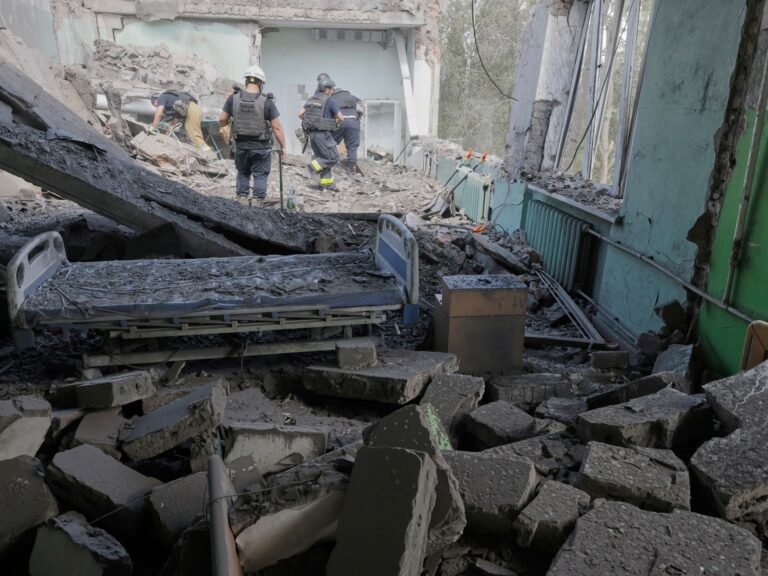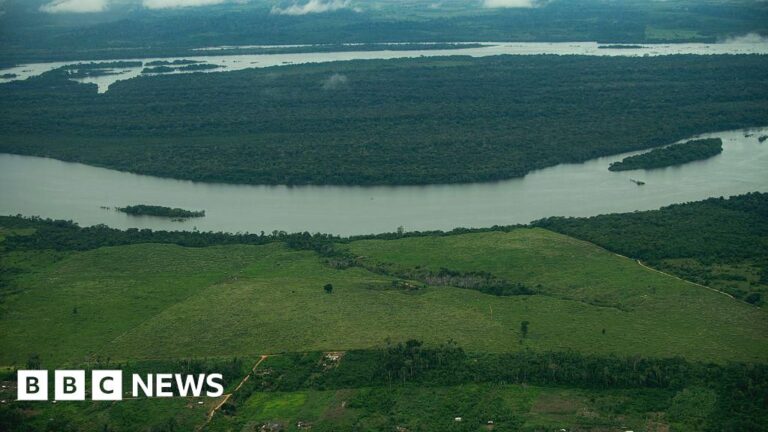Kyiv, Ukraine – As luck would have it, emergency doctor Elina Dovzhenko was far enough from her vehicle when a Russian drone struck it, breaking the windshield and splattering pieces of shrapnel around.
It was getting dark on July 9 in the bombed-out, nearly-abandoned city of Kupiansk which sits less than 5km (3 miles) from the front line in the northeastern Ukrainian region of Kharkiv – and just 40km (25 miles) west of the Russian border.
But there was definitely enough light left for the Russian drone operator on the front line’s opposite side to see that Dovzhenko’s vehicle was a white ambulance with red stripes parked near a shelling-damaged hospital where she and her colleagues were.
“We heard the drone move, it swirled and swirled around [the building], then we heard the blast,” Dovzhenko, 29, told Al Jazeera.
She and her colleagues were shocked and angry – but not surprised. They have been hearing regularly about Russian drones targeting ambulances, rescue workers and the people they were rescuing, mostly the elderly who refused to leave their homes, pets, kitchen gardens and family graves.
“They chase ambulances every other day. They definitely targeted us,” Denys Raievskyi, a 30-year-old paramedic and Dovzhenko’s ambulance partner, told Al Jazeera.
Their job is among the most dangerous professions in wartime Ukraine – some 200 ambulances have been damaged or destroyed by Russian shelling attacks each year since the full-scale invasion began in 2022, the World Health Organization (WHO) said in April.
“Ambulance workers and other personnel servicing health transport face a risk of injury and death three times higher than that of other healthcare service workers,” it said.
Premeditated, systematic attacks on ambulances are part of the Kremlin’s wider strategy to destroy Ukraine’s medical facilities and deprive millions of access to healthcare exacerbating their stress as well as physical and mental health problems.
Some 68 percent of Ukrainians already report a decline in their health compared with the pre-war period, the WHO said, and 46 percent are concerned about their mental health.
The WHO did not specify the number of casualties among ambulance workers, but said that since 2022 it has verified 1,682 attacks on healthcare facilities and workers in Ukraine that have resulted in 128 deaths and 288 injuries of health professionals and their patients.
Children in the line of fire
In an earlier assessment last August, it said the number of attacks was “the highest number WHO has ever recorded in any humanitarian emergency globally”.
“These attacks are a deliberate crime against humanity aimed at destroying civilians and those who stand on the front line fighting for [their] lives,” Ukraine’s Health Ministry said in July 2024.
The statement followed last year’s July 8 strike that killed two hospital workers, wounded eight children and injured hundreds in Okhmatdyd, Ukraine’s largest children’s hospital in Kyiv.
Russia used an X-101 missile that flies low to avoid detection and air defence, manoeuvres mid-flight and hits its target with a 10-metre (33ft) accuracy even if launched from 5,500km (3,420 miles) away.
Moscow routinely denies responsibility for deliberate attacks on healthcare, claiming it only strikes military sites and personnel.
International relief groups say they are aware of the gravity of the situation and are ready to keep supporting Ukraine’s healthcare.
“Unfortunately, these types of situation are not new,” Giorgio Trombatore, regional director for Eastern Europe with Project Hope, an international humanitarian group, told Al Jazeera. “But we are resilient, we’re going to continue.”
The group maintains 13 ambulances in four Ukrainian regions, five of them in Kharkiv – including the one struck by the drone in Kupiansk.
Other ambulances have also encountered drones in recent months, but the teams were not hurt.
“That’s something you cannot escape; eventually you need to be prepared,” Trombatore said. “Luckily, we didn’t report casualties from our team.”
His group also provides helmets and flak jackets, and some of the ambulances are bulletproof – something that helps counter Russia’s tactic of repeated strikes.
In one case, a Russian drone attack killed a civilian and wounded another in the village of Stetsivka in the northern region of Sumy on July 14.
After the ambulance team, supported by Project HOPE, arrived, a second drone exploded 2 metres (7ft) away from the vehicle.
“What saved them is that the vehicle was bulletproof,” Project HOPE’s spokesman Artem Murach told Al Jazeera.

‘Hope and faith’
The city of Kupiansk straddles both banks of the slow and strategically-located Oskil river, and once boasted a dozen factories, several colleges and a population of 22,000.
But days after the full-scale invasion of Ukraine began in 2022, the mayor surrendered the town and it became the de facto administrative centre of the Moscow-occupied chunk of the Kharkiv region.
The Russians were kicked out six months later during a daring Ukrainian counter-offensive.
But the town remained within reach of Russian artillery, drones and missiles, which have killed dozens of civilians, wounded hundreds and damaged almost every building.
Most of the residents – along with police officers, fire brigades and government officials – fled Kupiansk in early 2023 when Russian forces began approaching again.
But about 1,200 people – or about 7 percent of the pre-war population – remained.
“They’re scared to leave, they have no relatives to host them, they say, ‘I’d better die here, because it’s home,’” paramedic Raievskyi said.
He is no stranger to Russian pummelling – he lives with his wife in Saltivka, the most shelling-damaged region of Kharkiv, Ukraine’s second-largest city some 120km (75 miles) east of Kupiansk.
Raievskyi’s ambulance travels up to 1.5 hours to help the sick and the wounded, despite the almost constant shelling and omnipresent drones.
But no matter how severe their wounds are, he and his colleagues can’t treat their patients on the spot, especially if they have been hurt by a drone, because another strike is always a possibility.
One life-saving solution – a portable electronic jamming system that scrambles the drones’ navigation systems – no longer works in the Kharkiv region because Russians attach kilometres-long fibre-optic cables to their loitering munitions.
“Unfortunately, in Kupiansk all the Russian drones are fibre-optic,” his partner Dovzhenko said.











